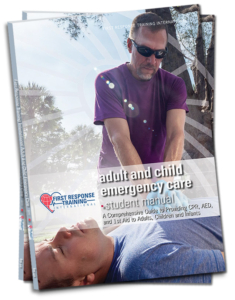Adult, Child & Infant Emergency Care Course
This course is cardio-pulmonary resuscitation (CPR), first aid, and automated external defibrillator (AED) use combined into one program. It is designed to teach the techniques to administer CPR, first aid, and utilize an AED in emergency situations involving infants, children, and adults.
This comprehensive program is appropriate for workplace training or general knowledge to be better prepared day to day. It meets all international standards, is OSHA* and ILCOR compliant, and has been accepted by the United States Coast Guard (USCG).
The CPR and AED components cover the knowledge needed to address one of the largest causes of death in the world. Intervening with this knowledge can possibly save a life. The first aid program reviews common techniques to treat serious emergencies, as well as less serious, more common issues.
Who this course is for:
- People wanting to be more prepared
- Businesses hoping to protect employees
- Outdoor enthusiasts
- Lifeguards, babysitters, and caregivers
- Those who need OSHA* and ILCOR compliant training or a course that has been accepted by the USCG
What you can expect to learn:
The Adult, Child, & Infant Emergency Care program is designed to train layperson rescuers for:
- CPR administration for children, infants, and adults
- AED use for children and adults.
- First aid for possible workplace incidents.
- First aid for common injuries.
What’s in it for you:
Upon successful completion of the course, graduates may:
- Recognize and evaluate an emergency and a victim
- Know how to activate or alert the emergency medical services (EMS)
- Be able to provide 1-person infant, child, and adult CPR to a non-breathing or injured person and administer the proper first aid.
- Properly use an automated external defibrillator (AED)
Course prerequisites
- Minimum age 18, 10 with parental consent
How to take this course
There are two components to your training in order to receive your certification. The first is academics and the second is skills. You must first pass your academics training to proceed to the second phase and work with an instructor in a classroom setting.
Step 1
Academics. We offer two options to complete your academics (eLearning or manual). To get started with eLearning, just click the eLearning link below and https://wearefrti.comyou’ll be off and running. If you prefer a manual, contact us via the link below and we will ship one to you.*
- eLearning: $27.95 – Click here for eLearning.
(OR)
- Manual: $37.08 – Click here for printed materials.
Once you complete your academics, you can begin your classroom training with a local instructor.
* Certain states, such as North Carolina, government agencies, and countries, require all portions of courses be taught in person. Check your local laws and regulations for specifics.
Step 2
Classroom. Search our instructor database to find a local training center to complete the skills portion of your training.
- Classroom costs: (vary by location) – Click here to Find an Instructor for your classroom training.
Once you complete your academics and classroom training, you will be issued a certification. You will then be a certified provider for CPR, AED and 1st Aid to Adults, Children and Infants.
Take this course
Adult & Child CPR, AED First Aid Course
Preview this course (Video)
What you will cover in this course
Our Certification Process
| Complete your academics online. | Schedule your classroom training. | You are now a certified user. |
*The Occupational Safety and Health Administration is an agency of the United States Department of Labor.
OSHA’s standard for first aid training in general industry is listed in 1910.151, provides:
Medical services and first aid
(a)The employer shall ensure the ready availability of personnel for advice and consultation on matters of plant health.
(b)In the absence of an infirmary, clinic, or hospital in near proximity to the workplace which is used for the treatment of all injured employees, a person or persons shall be adequately trained to render first aid. Adequate first aid supplies shall be readily available.
In the construction industry specifically, 1926.50(c) provides:
In the absence of an infirmary clinic, hospital, or physician, that is reasonably accessible in terms of time and distance to the worksite, which is available for the treatment of injured employees, a person who has a valid certificate in first-aid training from the U.S. Bureau of Mines, the American Red Cross, or equivalent training that can be verified by documentary evidence, shall be available at the worksite to render first aid.
The bloodborne pathogens standard at 1910.1030(g)(2)
This requires employers to provide training to any employees who have occupational exposure to blood or other potentially infectious materials, such as employees assigned medical or first aid duties by their employers. The standard at 29 CFR 1910.1030(b) defines “occupational exposure” as “reasonably anticipated skin, eye, mucous membrane, or parenteral contact with blood or other potentially infectious materials that may result from the performance of an employee’s duties.” If an employee is trained in first aid and identified by the employer as responsible for rendering medical assistance as part of his/her job duties, that employee is covered by the bloodborne pathogens standard.










